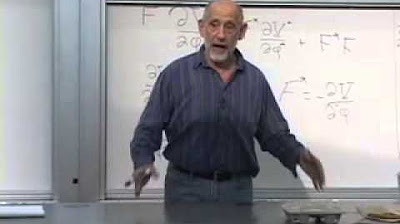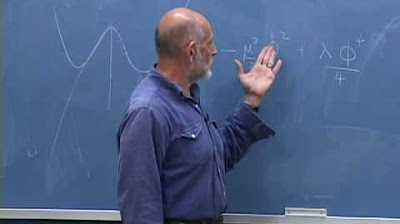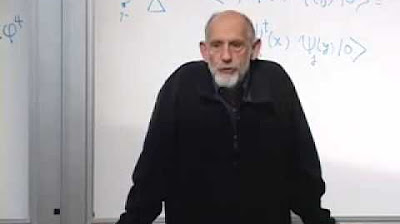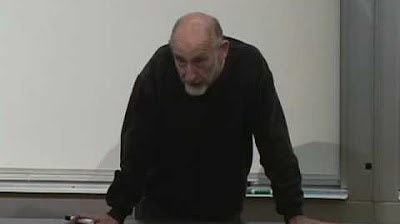Supersymmetry & Grand Unification: Lecture 10
TLDRThe video script delves into the fascinating world of Grand Unified Theories (GUT), specifically focusing on the SU5 model. It outlines the fundamental concepts of group theory as it relates to particle physics, explaining how particles and their antiparticles are organized into multiplets under the SU5 symmetry group. The lecturer discusses the defining representation of the SU5 group, the concept of particle multiplets, and the significance of group representations in classifying particles. The script also touches on the connection between GUT and supersymmetry, highlighting that while they are not inherently linked, combining them improves the numerical fit of certain physical models. The potential implications of these theories, such as the prediction of proton decay and the unification of coupling constants at high energy scales, are also explored. The lecture concludes with a discussion on the experimental efforts to detect proton decay and the theoretical predictions of proton lifetime in both the standard model and supersymmetry, emphasizing the ongoing search for evidence that could confirm or refute these advanced theoretical frameworks.
Takeaways
- 📚 The lecture discusses Grand Unified Theories (GUTs), specifically focusing on the SU(5) model, which attempts to unify the electromagnetic, weak, and strong nuclear forces into a single framework.
- 🔬 Group theory is fundamental to GUTs, with the standard model's SU(3) x SU(2) x U(1) fitting into the larger SU(5) group, which is based on special unitary transformations on five complex variables.
- 👉 Representations of groups are crucial, with particles forming multiplets under the action of symmetry groups. The script explains the defining representation and its complex conjugate, relevant for classifying particle states and their antiparticles.
- 🧬 The concept of irreducible representations is introduced, which are subsets of particle states that transform among themselves without mixing with other states under the group's action.
- ✨ The script touches on the connection between supersymmetry and GUTs, noting that while they are not inherently linked, combining them can provide a better numerical fit for certain physical phenomena.
- ⚛️ The SU(5) model predicts new gauge bosons, such as the X and Y bosons, which mediate interactions between quarks and leptons, leading to potential processes like proton decay.
- ⛔ Proton decay is a significant implication of GUTs, where a proton can decay into a positron and a neutral pion, mediated by the heavy X or Y bosons. However, experimental bounds suggest that if it occurs, the decay rate is extremely slow.
- ⚖️ The mass of the X and Y bosons is a critical factor in determining the rate of proton decay. The larger the mass, the slower the decay rate, which must be consistent with the observed stability of protons.
- ⏳ The lifetime of the proton is a key experimental test for GUTs. Current experimental bounds suggest a lifetime much longer than the age of the universe, requiring the X and Y bosons to have a mass around 10^16 GeV.
- 🔄 The running of coupling constants with energy is discussed, noting that in a unified theory, these constants should converge at high energy scales, suggesting a unification scale of around 10^16 GeV.
- 🔮 Supersymmetry, when included in the calculations, can improve the convergence of coupling constants, hinting at a possible link between supersymmetric particles and the unification of forces.
Q & A
What is the main subject of the lecture?
-The main subject of the lecture is Grand Unified Theories (GUTs), specifically focusing on the SU5 model, its problems, and its connection with supersymmetry.
What is the basis of Grand Unified Theories?
-Grand Unified Theories are based on group theory, extending the SU3 x SU2 x U1 of the standard model into a larger group like SU5.
What are group representations?
-Group representations are the mathematical structures that describe how symmetry groups act on particle multiplets, scrambling them up in various ways.
How does the SU2 group relate to particle spin?
-SU2 classifies the spin representations of particles, corresponding to their angular momentum. It is closely related to the rotations of three-dimensional space.
What is the defining representation in group theory?
-The defining representation is a basic representation where the group is described by special unitary matrices acting on column vectors with complex entries.
What is the significance of the complex conjugate representation in particle physics?
-The complex conjugate representation is significant because it corresponds to the transformation behavior of antiparticles. If particles transform under a certain representation, their antiparticles transform under the complex conjugate of that representation.
How does the SU5 model represent particles?
-In the SU5 model, particles are represented as five-dimensional objects, or 'fermions,' which include a neutrino, an electron, and three down-type antiquarks.
What are the X and Y bosons in the context of SU5 GUTs?
-The X and Y bosons are hypothetical gauge bosons in SU5 GUTs that are responsible for transitions between quarks and leptons, such as a down-type antiquark transforming into an electron or a neutrino.
What is the connection between supersymmetry and Grand Unification?
-Supersymmetry and Grand Unification are not theoretically implied by each other, but when combined, they provide a numerically better fit to certain aspects of particle physics. Supersymmetry can help unify the coupling constants at a high energy scale.
Why is proton decay considered dangerous in the context of GUTs?
-Proton decay is considered dangerous because if it occurred rapidly, it would mean that protons, which are essential for the stability of atoms and thus all matter, would break down into positrons and other particles, leading to the destruction of matter as we know it.
What is the current experimental bound on the proton's lifetime?
-The current experimental bound on the proton's lifetime is greater than 10 to the 33 years, which is derived from observing a large number of protons over time and not observing any decay.
Outlines
📚 Introduction to Grand Unified Theories (GUTs)
The video begins with an introduction to Grand Unified Theories, focusing on the SU(5) model. The lecturer emphasizes that while there are many versions of GUTs, the presentation will only explore one version. The aim is to understand the basics of GUTs, their challenges, and potentially their connection to supersymmetry. Group theory is highlighted as the foundational basis for GUTs, with the standard model's SU(3) x SU(2) x U(1) fitting into the larger SU(5) group. The concept of group representations is introduced as essential for classifying particle multiplets.
🧬 Group Representations and Particle States
The paragraph delves into group representations, specifically the defining representation of SU(n), which involves column vectors and special unitary matrices. The complex conjugate representation is also discussed, which is relevant for understanding the transformation of particle states and antiparticle states. The lecturer explains how particles and antiparticles transform under different representations, leading to a better understanding of their behavior in the context of GUTs.
🤔 Multiparticle States and Group Theory
The discussion continues with the implications of having multiple particles within the context of group theory. The focus is on how the states of two particles are calculated when considering the group SU. The concept of the exclusion principle is touched upon, highlighting that two particles cannot occupy the same state due to their distinct locations. The lecturer further explains how to transform these states by considering the group action on the individual particles.
🔄 Spin States and Multiplets
The lecturer explores the combination of spin states, using the example of two half-spin particles that can form either a spin zero or a spin one state. The symmetric and antisymmetric combinations of these states are discussed, with the singlet state corresponding to zero spin and the triplet state to spin one. The importance of irreducible representations in this context is also highlighted.
🌐 Constructing Representations for SU(5)
The construction of representations for the SU(5) group is detailed, with the lecturer explaining how to work out the implications of the group theory for SU(5). The focus is on understanding the different types of gauge bosons and their roles in particle interactions within the SU(5) framework. The concept of complex conjugate representation is also revisited in this context.
🚀 Proton Decay and the Implications of GUTs
The possibility of proton decay, a consequence of GUTs, is discussed. The lecturer explains that while proton decay has not been observed, the theoretical implications require the proton to have an extremely long lifetime. The mass of the X and Y bosons, which are key to proton decay, must be very high to slow down the decay process to a rate that is consistent with current experimental bounds.
🔬 Running Coupling Constants and Unification Scale
The paragraph covers the concept of running coupling constants and how they can indicate a unification scale where the three fundamental forces' coupling constants meet. The lecturer discusses how the coupling constants for the strong, weak, and electromagnetic interactions run with energy and approximately cross at a high energy scale, suggesting a point of unification. The implications of this for the validity of GUTs are considered.
🔗 Supersymmetry and its Relation to GUTs
The final paragraph touches on the relationship between supersymmetry and GUTs. While not theoretically required, the addition of supersymmetry to the calculations can lead to a better agreement in the running of coupling constants. The lecturer also mentions that in supersymmetry, the predicted proton lifetime can vary widely, from extremely short to incredibly long, but does not provide a precise prediction.
Mindmap
Keywords
💡Grand Unified Theories (GUT)
💡Group Theory
💡SU(5)
💡Representation Theory
💡Gauge Bosons
💡Proton Decay
💡Supersymmetry (SUSY)
💡Running Coupling Constants
💡Spontaneous Symmetry Breaking
💡Standard Model
💡Neutrino
Highlights
Grand Unified Theories (GUTs) aim to combine the three fundamental forces of the standard model into a single framework based on group theory.
The focus is on the SU(5) model, which extends the standard model's SU(3) x SU(2) x U(1) symmetry.
Group representations are essential for classifying particle multiplets and understanding their transformation properties.
The defining representation of SU(n) involves column vectors and special unitary matrices acting on these vectors.
The concept of particle-antiparticle symmetry is introduced through complex conjugate representations.
The speaker discusses the construction of higher-dimensional representations through direct and symmetric products of group representations.
The unification of quarks and leptons into a single multiplet under SU(5) is explored.
The existence of new gauge bosons, the X and Y bosons, which mediate transitions between quarks and leptons, is postulated.
Proton decay is a significant consequence of GUTs, which, if observed, would have profound implications for our understanding of particle physics.
The mass of the X and Y bosons must be very large (around 10^16 GeV) to prevent rapid proton decay, which has not been observed.
The running of coupling constants with energy is discussed, highlighting how they approach each other at high energies, suggesting a grand unification scale.
Supersymmetry is introduced as a potential solution to the hierarchy problem and its empirical connection to GUTs.
The speaker explains that supersymmetry can improve the convergence of coupling constants, suggesting a unification scale around 10^16 GeV.
The current experimental lower bound on the proton lifetime is over 10^33 years, which constrains the parameters of GUTs.
The implications of the unification scale for the strong, weak, and electromagnetic forces are discussed.
The theoretical and experimental efforts to detect proton decay and measure the proton lifetime are ongoing and crucial for testing GUTs.
The lecture concludes with a discussion on the broader impact of GUTs and supersymmetry on our understanding of fundamental physics.
Transcripts
Browse More Related Video
5.0 / 5 (0 votes)
Thanks for rating:





